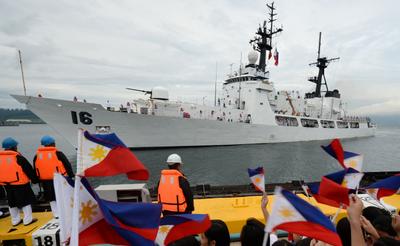Tokyo will extend a stand-by credit loan for the Philippines’ disaster preparedness and offer continuous assistance to the Mindanao peace process, among other initiatives.
When it was created in 2011, the purpose of the Japan–Philippines Strategic Partnership was simply to facilitate the exchange of goods, services, people and investments between the two economies through the implementation of the Japan–Philippines Economic Partnership Agreement. But ever since Abe was elected, the relationship has shifted focus to maritime security cooperation.
So it was no surprise when Prime Minister Abe promised 10 patrol vessels to the Philippine Coast Guard through a loan agreement. In itself, this should not alarm anyone. Both the Philippines and Japan are maritime nations who want to ensure maritime security and freedom of navigation in the region’s vital Sea Lines of Communication.
In context, however, this cooperation can be seen as a clear response to a common threat — China’s maritime build-up in the East and South China Seas. The relationship with Japan is just one element in the Philippines’ broader strategy: to intensify defence cooperation with its allies to compensate for its limited military capability and insecurity.
Manila’s multilateral approach to security in the South China Sea is also a bid to counter Beijing’s insistence on bilateralism, which may legally and strategically undermine Manila’s territorial claims. This is why President Aquino will give the United States and Japan access to the Subic Naval Base, a former US military facility facing the South China Sea.
Japan, too, gains from increased cooperation. The Philippines will play a role in Japan’s nascent defence strategy of deploying Japanese marine troops and surveillance drones to protect its remote islands in the East China Sea. Also, a better relationship with the Philippines fits in with Japan’s foreign policy strategy of re-engaging ASEAN.
But Japan cannot be an effective counterweight to China on its own. China is not likely to be intimidated. It is only the United States, still the dominant Pacific power, which can guarantee peace and stability in the Asia-Pacific through its military presence.
Still, the revitalised partnership will be useful, and it is not just about counter-balancing China. Prime Minister Abe and President Aquino pledged to bolster economic cooperation at a time when both Japan and the Philippines are undergoing an economic renaissance and gaining international confidence by combining fiscal stimulus with economic reform.
But the Japanese government knows its economy needs closer ties with vibrant ASEAN countries if reforms are to succeed. As the fastest-growing economy in the region, the Philippines offers a competitive investment destination and a lucrative market for Japanese companies, who are looking elsewhere than China in light of anti-Japan protests, which disrupt business.
On the other hand, President Aquino thinks Japan can be a major driver of the Philippines’ future economic growth. His administration is turning to foreign direct investments (FDI) to expand the manufacturing sector. In 2012, Japan was the Philippines’ largest trade partner, with roughly US$16 billion in total bilateral trade, and the second-biggest source of FDI.
Prime Minister Abe’s visit is seen as catalysing Tokyo’s support for President Aquino’s key programs in infrastructure development, disaster preparedness, and the Mindanao peace process through official development assistance. Japan is the leading source of such aid to the Philippines and it has poured money into Mindanao, where the Philippine government has been negotiating for a comprehensive peace pact with the Moro Islamic Liberation Front. Aquino clearly wants a final peace accord to form part of his legacy, and Japan has contributed significantly to the process through its development projects under the framework of the Japan–Bangsamoro Initiative for Reconstruction and Development, or J-BIRD.
During Abe’s visit, Philippine survivors of Japanese military sexual slavery during World War II urged Aquino to bring up their demand for official apology. But President Aquino did not delve into the issue of comfort women and even suggested that the Philippines has moved on from its historic conflict with Japan. The Philippine government has said previously that it would back a rearmed Japan shorn of its pacifist constitution to counter-balance China in the Asia Pacific.
Japan’s and the Philippines’ strategic and economic interests are converging. Their relationship is no longer defined by the bitter memories of brutal Japanese occupation. Instead, their priorities are to ensure economic growth and counter China’s assertiveness.
Julius Cesar I. Trajano is a senior analyst at S. Rajaratnam School of International Studies (RSIS), Nanyang Technological University.
This article was first published here, as RSIS commentary No. 146/2013


Although Japan and Philippines are united against China, can their combined militaries even stand up the largest military force in the world and the 3rd most powerful country?